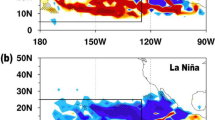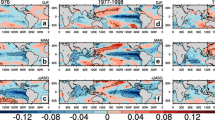Abstract
This study investigates how the Pacific Decadal Oscillation (PDO) modulates the effect of El Niño/Southern Oscillation (ENSO) on tropical cyclone rapid intensification (RI) in the western North Pacific. The analysis shows that the interannual relationship between ENSO and annual RI number in warm PDO phases is strong and statistically significant. In cold PDO phases, however, there is no significant correlation between ENSO and RI on the interannual timescale. The enhancement of the interannual ENSO–RI relationship in warm PDO phases is mainly attributable to the change of the environmental vertical wind shear. The PDO in warm (cold) phases can strengthen (weaken) an El Niño event to increase (reduce) the effects of the warm pool of water over the equatorial Pacific in typhoon season by local diabatic heating. El Niño events are accompanied by the stronger Walker circulation in the equatorial Pacific in the warm PDO phase than in the cold PDO phase. In contrast, the Walker circulation pattern and amplitude associated with La Niña events is less affected by the alternate PDO phase. This tends to make the atmospheric response to ENSO stronger (weaker) in warm (cold) PDO phase, and so is the atmospheric teleconnection of ENSO. Our results indicate that the stratification of ENSO-based statistical RI forecast by the PDO can greatly improve the accuracy of statistical RI predictions.











Similar content being viewed by others

References
An SI, Wang B (2000) Interdecadal change of the structure of the ENSO mode and its impact on the ENSO frequency. J Clim 13:2044–2055
Ashok K, Yamagata T (2009) Climate change: the El Niño with a difference. Nature 461:481–484
Ashok K, Behera SK, Rao SA, Weng H, Yamagata T (2007) El Niño Modoki and its possible teleconnection. J Geophys Res 112:C11007. doi:10.1029/2006JC003798
Camargo SJ, Sobel AH (2005) Western North Pacific tropical cyclone intensity and ENSO. J Clim 18:2996–3006
Camargo SJ, Robertson AW, Gaffney SJ, Smyth P, Ghil M (2007) Cluster analysis of typhoon tracks: part II: largescale circulation and ENSO. J Clim 20:3654–3676
Compo GP et al (2011) The twentieth century reanalysis project. Q J R Meteorol Soc 137:1–28
Elsner JB, Liu KB (2003) Examining the ENSO typhoon hypothesis. Clim Res 25:43–54
Gill AE (1980) Some simple solutions for heat-induced tropical circulation. Q J R Meteorol Soc 106:447–462
Kao HY, Yu JY (2009) Contrasting Eastern Pacific and Central Pacific types of ENSO. J Clim 22:615–631
Kaplan J, DeMaria M (2003) Large-scale characteristics of rapidly intensifying tropical cyclones in the north Atlantic basin. Weather Forecast 18:1093–1108
Kaplan J, DeMaria M, Knaff JA (2010) A revised tropical cyclone rapid intensification index for the Atlantic and East Pacific basins. Weather Forecast 25:220–241
Kim HM, Webster PJ, Curry JA (2009) Impact of shifting patterns of Pacific ocean warming on North Atlantic tropical cyclone. Science 325:77–80
Kim HM, Webster PJ, Curry JA (2011) Modulation of north Pacific tropical cyclone activity by three phases of ENSO. J Clim 24:1839–1849
Knutson TR, Manabe S, Gu D (1997) Simulated ENSO in a global coupled ocean–atmosphere model: multidecadal amplitudemodulation and CO2 sensitivity. J Clim 10:131–161
Krishnamurthy L, Krishnamurthy V (2013) Influence of PDO on South Asian summer monsoon and monsoon–ENSO relation. Clim Dyn. doi:10.1007/s00382-013-1856-z
Kug JS, ** FF, An SI (2009) Two types of El Nino events: cold Tongue El Niño and warm pool El Niño. J Clim 22:1499–1515
Kurtzman D, Scanlon BR (2007) El Niño-Southern Oscillation and Pacific Decadal Oscillation impacts on precipitation in the southern and central United States: evaluation of spatial distribution and predictions. Water Resour Res 43:W10427. doi:10.1029/2007WR005863
Lee T, McPhaden MJ (2010) Increasing intensity of El niño in the central-equatorial Pacific. Geophys Res Lett 37:L14603. doi:10.1029/2005GL022860
Li RCY, Zhou W (2012) Changes in western Pacific tropical cyclones associated with the El niño–Southern oscillation cycle. J Clim 25:5864–5878. doi:10.1175/JCLI-D-11-00430.1
Lin I-I, Wu CC, Pun IF, Ko DS (2008) Upper-ocean thermal structure and the western North Pacific category 5 typhoons. Part I: ocean features and the category 5 typhoons’ intensification. Mon Weather Rev 136(9):3288–3306
Mantua NJ, Hare SR, Zhang Y, Wallace JM, Francis RC (1997) A Pacific interdecadal climate oscillation with impacts on salmon production. Bull Am Meteorol Soc 78(6):1069–1079
Newman M (2007) Interannual to decadal predictability of tropical and North Pacific sea surface temperatures. J Clim 20:2333–2356
Penland C, Sardeshmukh PD (1995) The optimal growth of tropical sea surface temperature anomalies. J Clim 8:1999–2024
Shu SJ, Ming J, Chi P (2012) Large-scale characteristics and probability of rapidly intensifying tropical cyclones in the western north pacific basin. Weather Forecast 27:411–423
Smith TM, Reynolds RW, Peterson TC, Lawrimore J (2008) Improvements to NOAA’s historical merged land-ocean surface temperature analysis (1880–2006). J Clim 21:2283–2296
Sun F, Yu JY (2009) A 10–15-yr modulation cycle of ENSO intensity. J Clim 22:1718–1735
Verdon DC, Franks SW (2006) Long-term behaviour of ENSO: interactions with the PDO over the past 400 years inferred from paleoclimate records. Geophys Res Lett 33:L06712. doi:10.1029/2005GL025052
Vimont DJ, Battisti DS, Hirst AC (2001) Footprinting: a seasonal connection between the tropics and midlatitudes. Geophys Res Lett 28:3923–3926
Vimont DJ, Battisti DS, Hirst AC (2003a) The seasonal footprinting mechanism in the CSIRO general circulation models. J Clim 16:2653–2667
Vimont DJ, Wallace JM, Battisti DS (2003b) The seasonal footprinting mechanism in the Pacific: implications for ENSO. J Clim 16:2668–2675
Wada A, Chan JCL (2008) Relationship between typhoon activity and upper ocean heat content. Geophys Res Lett 35:L17603. doi:10.1029/2008GL035129
Wang B, Chan JCL (2002) How strong ENSO events affect tropical storm activity over the western North Pacific. J Clim 15:1643–1658
Wang CZ, Wang X (2013) Classifying El Niño Modoki I and II by different impacts on rainfall in Southern China and typhoon tracks. J Clim 26(4):1322–1338
Wang B, Zhou X (2008) Climate variation and prediction of rapid intensification in tropical cyclones in the western North Pacific. Meteorol Atmos Phys 99:1–16. doi:10.1007/s00703-006-0238-z
Wang L, Chen W, Huang R (2008) Interdecadal modulation of PDO on the impact of ENSO on the east Asian winter monsoon. Geophys Res Lett 35:L20702. doi:10.1029/2008GL035287
Wang X, Wang D, Zhou W (2009) Decadal variability of twentieth-century El Niño and La Niña occurrence from observations and IPCC AR4 coupled models. Geophys Res Lett 36:L11701. doi:10.1029/2009GL037929
Wang CZ, Li CX, Mu M, Duan WS (2013) Seasonal modulations of different impacts of two types of ENSO events on tropical cyclone activity in the western North Pacific. Clim Dyn 40(11–12):2887–2902
Wang X, Zhou W, Li C, Wang D (2014) Comparison of the impact of two types of El Niño on tropical cyclone genesis over the South China Sea. Int J Climatol 34:2651–2660
Weng H, Ashok K, Behera SK, Rao AS, Yamagata T (2007) Impacts of recent El Niño Modoki on dry/wet conditions in the Pacific rim during boreal summer. Clim Dyn 29:113–129
Weng H, Ashok K, Behera SK, Yamagata T (2009) Anomalous winter climate conditions in the Pacific rim during recent El Niño Modoki and El Niño events. Clim Dyn 29:113–129
Wolter K, Timlin MS (1998) Measuring the strength of ENSO events: how does 1997/98 rank? Weather 53:315–324
Wu R, Wang B (2002) A contrast of the east Asian summer monsoon–ENSO relationship between 1962–77 and 1978–93. J Clim 15(22):3266–3279
Yeh SW, Kirtman BP (2004) Tropical Pacific decadal variability and ENSO amplitude modulation in a CGCM. J Geophys Res 109:C11009. doi:10.1029/2004JC002442
Yeh SW, Kug JS, Dewitte B, Kwon MH, Kirtman BP, ** FF (2009) El Niño in a changing climate. Nature 461:511–514
Yu JY, Kim ST (2011) Reversed spatial asymmetries between El Niño and La Niña and their linkage to decadal ENSO modulation in CMIP3 models. J Clim 24:5423–5434
Yu B, Zwiers FW (2007) The impact of combined ENSO and PDO on the PNA climate: a 1,000-year climate modeling study. Clim Dyn 29:837–851
Zhang Y, Wallace JM, Battisti DS (1997) ENSO-like interdecadal variability: 1900–93. J Clim 10:1004–1020
Acknowledgments
This study was jointly supported by the National Basic Research Program of China (2013CB430304), National Natural Science Foundation (41376015, 41376013, 41306006, 41206178, and 41176003) of China, and National High-Tech R&D Program (2013AA09A505) of China, and Global Change and Air-Sea Interaction (GASI-01-01-12) of China. H. Liu’s work was supported by the University of Miami’s Cooperative Institute for Marine and Atmospheric Studies (Cooperative Agreement #NA10OAR4320143) and NOAA’s Atlantic Oceanographic and Meteorological Laboratory. The 6-h tropical cyclone best-track data is obtained from the Joint Typhoon Warning Center (http://www.usno.navy.mil/JTWC/). SODA data is downloaded from web site at http://dsrs.atmos.umd.edu/DATA/soda_2.2.4/. The twentieth century Reanalysis V2 data is provided by the NOAA/OAR/ESRL PSD, Boulder, Colorado, USA, from their Web site at http://www.esrl.noaa.gov/psd/.
Author information
Authors and Affiliations
Corresponding author
Rights and permissions
About this article
Cite this article
Wang, X., Liu, H. PDO modulation of ENSO effect on tropical cyclone rapid intensification in the western North Pacific. Clim Dyn 46, 15–28 (2016). https://doi.org/10.1007/s00382-015-2563-8
Received:
Accepted:
Published:
Issue Date:
DOI: https://doi.org/10.1007/s00382-015-2563-8



